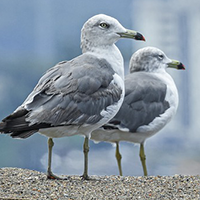The public's affection of birds can lead us to ignore serious health risks that are associated with pest birds. People who would never tolerate a colony of rats living in their attic will turn a blind eye towards pigeons entrenched in the rafters of their roof. Yet, in terms of disease and damage, the two pests are quite similar. In order to better understand how nuisance birds (or rats for that matter) spread disease, it helps to understand the basics of disease and transmission.

What is a Disease?
Diseases caused by foreign invaders into the body are known as "infectious diseases". The invading agents responsible for the majority of infectious diseases are grouped into five categories; viruses, bacteria, mycotic (fungal), protozoal and rickettsial. From a layman's standpoint, the classification and definitions of disease are less important than how these diseases spread, and how can we protect ourselves from them. Diseases need to be transported from place to place in order to spread. Birds are a perfect mechanism for spreading disease as they easily travel across great distances. Birds can carry over 40 types of parasites and host over 60 types of infectious diseases.
How Pest Birds Harbor and Spread Disease
Infectious diseases are carried by birds in the following ways: the disease lives in the bird and is passed on in bird feces/ poop, when the bird defecates; the disease lives near the bird's environment and; the disease lives inside the bird as a parasite. From understanding how the bird harbors diseases, we can demonstrate the four ways the diseases are passed by the bird to humans.
Food & Water Contaminated with Feces
The most obvious example is when the diseased bird directly defecates into human food or a water source. In the summer of 93, New York faced a health crisis when several hundred people came down with a mysterious ailment that was traced back to sea gull droppings in an old city reservoir.
Health inspectors are quick to shut down a food processing plant if nuisance birds are found inside. Besides direct contamination, airborne spores from drying feces in air ducts and vents can settle on exposed food and transfer infectious disease. Several cases of food poisoning (Salmonella) every year can eb traced to this transmission route.
Inhalation of Fecal Dust
When bird feces and/or the contaminated soil it rests on, dries or is disturbed, microscopic pieces break off and become airborne. These airborne particles can contain fungi and/or bacteria. When inhaled by humans, the warm, moist environment inside the lungs provides a breeding ground disease and resulting health issues. Common symptoms of this type of infection are flu-like: coughing, elevated temperature, restricted breathing and general body fatigue, lasting two to four days. The bodies defenses will contain the invaders even before minor symptoms appear, but in a small percentage of cases, major infection causing long term disability or even death can occur. There is no medical cure for internal fungal infections.
Contact With Feces
Infection occurs when a worker or resident gets fecal dust or droppings in an open wound or cut. This can happen when handling old rusty, sharp porcupine wire ledge products covered with bird poop/feces. The wound site becomes red, puffy and puss-filled. Antibiotics are often needed to cure the infection. In some rare cases, infection of the blood (septis) or internal infection can also occur causing serious illness or death. Proper attire and care must always be used when cleaning a bird site or installing bird control products. If a cut or injury occurs, thoroughly wash and disinfect the wound and cover with a sterile bandage to minimize risk of infection.
Parasites
Pest birds harbor ticks, fleas, mites and other parasites. Parasites that live on birds can pass disease between different species. The parasite bites an infected animal or bird, and sucks in blood containing the disease. When the parasite bites its next victim (such as a human or other animal) it passes the disease to the new victim. Over 40 types of parasites can live either on the birds, in their nests or in the places they roost. They are responsible for the transmission of several hundred viral and bacterial agents. These diseases include plague, encephalitis, West Nile Virus, pox and meningitis. Control of these parasites is a crucial phase of any bird control project. If not done by a professional, this threat can be aggravated by the incorrect installation of bird control products . If the parasites are properly exterminated after birds are excluded from a site, the mites, fleas, ticks etc. will seek a new host, often the human inhabitants. A proper bird control project should always include cleaning and disinfecting.
How to Handle Pest Birds Problems From A Health Perspective
Using our understanding of how nuisance birds play a roll in disease transmission, we can develop a few guidelines when dealing with bird infestations. When evaluating a health risk potential, the professionals at Hawkeye look for: droppings or nesting materials inside air vents, birds around food or beverage production facilities, or large amounts of droppings in enclosed or open areas. These are the types of situations where disease can be easily spread.
A few pigeons around your park bench may not be not cause for panic, but 20+ birds living in the rooftop air ducts of a restaurant is a serious health concern that requires immediate and effective action. Pest control professionals and do-it yourselfers must take the proper precautions when tackling bird control projects. Respirators, goggles and protective clothing must be used when cleaning up bird sites, particularly enclosed areas out of the sun with large amounts of droppings and nesting material. It is not enough to only remove the birds, all potential sources of infectious disease and/or parasites must be properly exterminted and thoroughly disinfected.
















